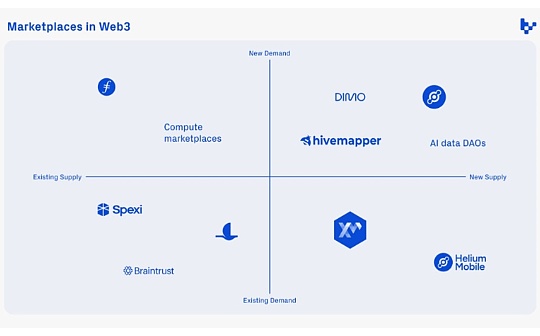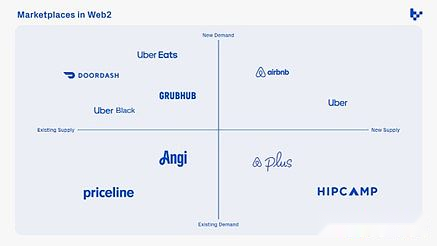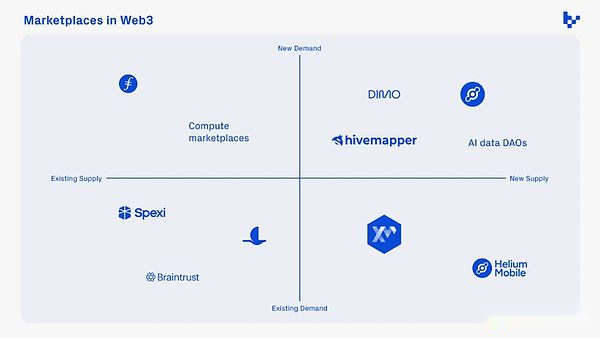
Author: Li Jin, partner of Variant Fund; Translation: Bitchain Vision xiaozou
A typical application of cryptocurrencies in the market is as a mechanism to drive growth: the use of tokens to incentivize supply and/or demand inflows.A wide variety of DePIN networks and other market tokenizations have successfully applied this model to overcome the cold start problem.
When analyzing market tokenization, we have formed a framework to think about the various market tokenization methods and the advantages and disadvantages of each method.
At the most basic level, the market promotes transactions between supply and demand.Over the past few decades, we have witnessed various evolutions in the market.These evolutions either unlock new sources of supply and demand or summarize excellent experiences for existing supply and demand in participating markets.
In short, the market can be divided according to whether they are targeting new or existing supply, meeting new or existing demand.
First, let’s look at the specific definition:
-
New demand: converting non-consumers into consumers
Markets that meet new demands expand the product or service market by transforming former non-consumers into consumers.For example, UberX basically transforms consumers who used other modes of transportation (public transportation, private cars, etc.) into carpooling users.
-
New Supply: Convert non-suppliers to suppliers
Markets targeting new supply are expanding the product or service market by activating non-suppliers who previously did not provide services or products.For example, Airbnb uses more bedrooms or sofas to increase new supply on the homeowner side.
-
Existing demand: Get existing consumers to use new markets
The market that taps existing demand is attracting existing product or service users to new markets.Think about it: Angie’s List’s superior vertical experience may pull existing demand away from a more comprehensive market like Craigslist.
-
Existing Supply: Getting existing suppliers to use new markets
Similar to the previous point, but targeting suppliers.Take Faire as an example, a B2B wholesale market that connects brands and retailers.
1,Web2market
It will be helpful to draw on the market approach of Web2.By observing the history of market development and how the greatest success comes about, we can better understand market dynamics.

The biggest disruption in Web2 market innovation—and therefore the biggest achievement—occur in the quadrant of “new supply + new demand”.When you open up new supply and new demand, you make the whole cake bigger.This echoes Clay Christensen’s view of disruptive innovation: Christensen believes that focusing on previous non-consumers can open up a larger market than locking in existing consumers.
Compared with the “Existing Supply + Existing Demand” quadrant, the markets in this quadrant usually adopt existing transaction methods (Whitepages, travel agencies, etc.) and will build better products to serve these transactions.For example, Priceline, which provides travel reservation services and OpenTable, which provides restaurant reservation services.The convenience and ease of use of digital discovery and booking enable them to create 10 times better experiences than offline markets, allowing them to gain market share.
There are two quadrants left: one is that the supply is still there, but the demand is new; the other is that the demand is still there, but new supply appears.In both cases, growth may come from conversions from new consumers or suppliers.There are a large number of businesses coming from these quadrants.For example, DoorDash creates a new source of demand for existing restaurant supply (consumers want to deliver food on demand).By converting non-consumers into consumers, opening up a new revenue channel for restaurants—DoorDash earned $2.3 billion last year.
Obviously, there is overlap in these quadrants, and the market usually starts in one quadrant and then migrates or expands to other quadrants.However, this framework helps quantify the size of the potential market based on existing market dynamics and potential supply and demand.
2,Web3Market Matrix
Similar to the web2 market, there are four common classification methods for market tokenization.

Possessing the “Existing Supply + Existing Demand” quadrant are those markets seeking to improve existing platforms – for example, providing participants with better products or better economic benefits.For example, Braintrust is a freelancer market that shares ownership with users through tokens and charges a lower commission rate, which beats the industry standard of HR in a commission rate of up to 40%.Blackbird is a restaurant loyalty platform that targets existing restaurants and offers a lower commission rate for payments using cryptocurrency.
In the “New Demand + New Supply” quadrant, business can create entirely new markets.For example, DIMO allows drivers to acquire tokens by transmitting their vehicle data, thus unlocking a new supply and demand pool in the automotive data field.Drivers who would not have provided vehicle data were attracted to the network by token incentives, and this new data supply unlocked new demand.Helium is another example: individuals set up hotspots at home and receive rewards by using the LoRaWan system to create a decentralized wireless IoT network.
Market tokenization is very suitable for the “new demand + new supply” quadrant, because token incentives can develop the market in an orderly manner by subsidizing one party to join the market before the other party.Compared with the web2 paradigm, this is a new capability, in which the market must simultaneously expand supply and demand.
The risk of establishing a “new supply + new demand” quadrant is that supply or demand is not sufficient to base large revenue opportunities, or that new suppliers and/or new demand will be around longer than expected.However, founders may also underestimate the size of emerging markets.For example, Uber founders estimated in their seed round presentation that, in the most optimistic case, their annual revenue should be $1 billion.This proved to be a big underestimation of potential transportation demand—Uber’s revenue reached $8.7 billion last year.Founders must prepare for both possibilities, develop flexible business models to quickly scale up when market responses are stronger than expected, and also develop contingency plans for situations where growth is lower than expected.
3,rightBuilderThe impact of
It is crucial to understand whether a new market is targeted at new supply and demand or existing supply and demand, because it determines the strategy to enter the market and what aspects builders need to stand out in order to win the market’s supply and demand share.
-
For new supply
To activate new supply, builders must educate potential suppliers why they should participate in this new market and provide an attractive value proposition.This usually requires convincing them that they will get money or other benefits.
If the value proposition is money, builders must ensure that their solutions are competitive in the broader market for profit opportunities.For example, GPU resource providers can choose to rent to different GPU markets, so the revenue potential of the new platform must be attractive enough.Participation as an active supplier or a passive supplier is another factor affecting retention and scalability.
-
For existing supply
Finding existing suppliers and convincing them to switch to a new platform requires developing strong products and market entry activities, depending on the nature of the supply.If existing supply includes businesses (B2B), the founder establishes relationships with and benefits from these suppliers.If the existing supply is made up of individuals (B2C), then the founder needs to have strong storytelling and marketing skills, as well as the ability to translate deep user insights into products.
-
Meet new demands
Creating new needs requires builders to perform well in the creation of new markets.The founder must effectively convey why this new product or service is valuable and worthy of user attention.This requires skillful storytelling ability and narrative construction, as well as a set of powerful customer acquisition skills.In the crypto space, token incentives can also help drive new demand for the market.
-
Meet existing needs
To win existing needs, founders need to be good at acquiring customers, meet the needs of potential users, and convince them to turn to different platforms.This requires understanding their current needs and providing a significantly better solution.For example, the new vertical on-demand market disruptors transform users from Craigslist and other common platforms with a 10-fold better user experience.In the crypto world, using token incentives to convince end users to switch to a new platform is an effective strategy, as demonstrated by various vampire attacks and token incentive programs.
4, market tokenization prospects
Market tokenization is unique in the crypto world because they face competition not only from other crypto projects, but also from all other web2 markets in the vertical field.This is because the Web3 market deploys token incentives as a guide mechanism, and the core of the market still depends on the success of the transaction.For example, the GPU tokenized computing market such as Ionet, Akash, Render, etc. has a competitive relationship with traditional computing services such as Lambda, Coreweave and AWS.
The lifeblood of any market is dependent on liquidity – the ability to find counterparties for target transactions.While token incentives can drive initial growth and help overcome cold start issues, long-term success still depends on the core utility of the market: supply and demand matching.Ultimately, market tokenization must build a strong enough market with an excellent experience that attracts and retains participants.








